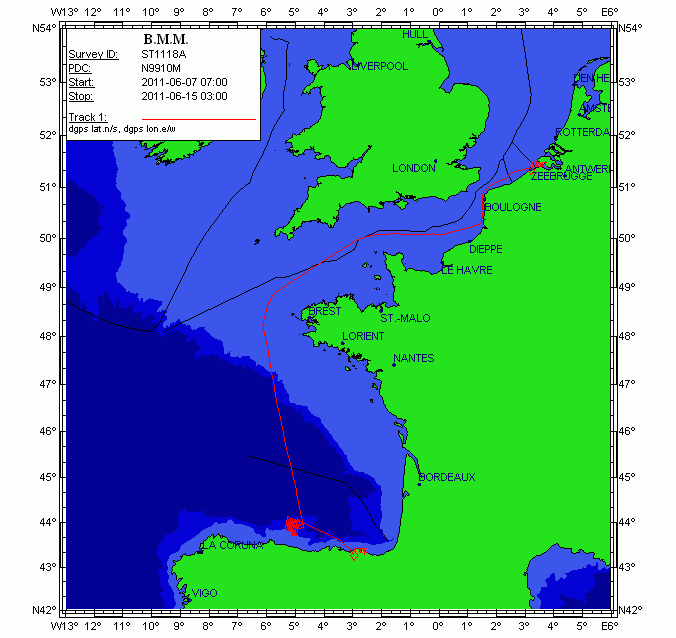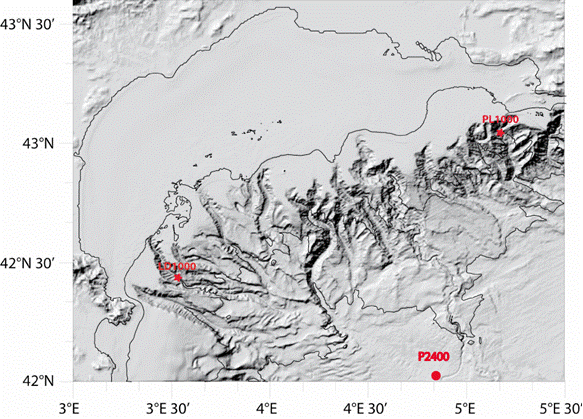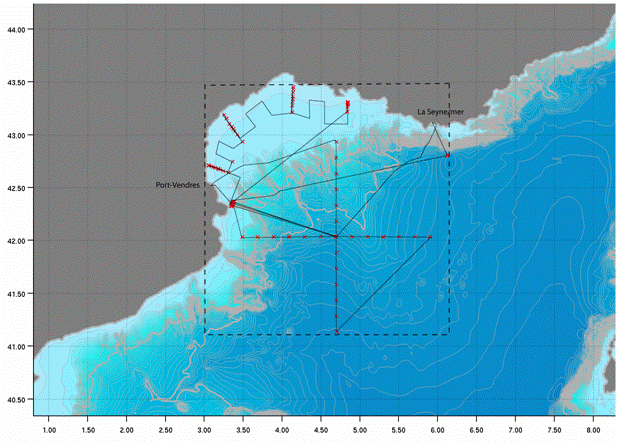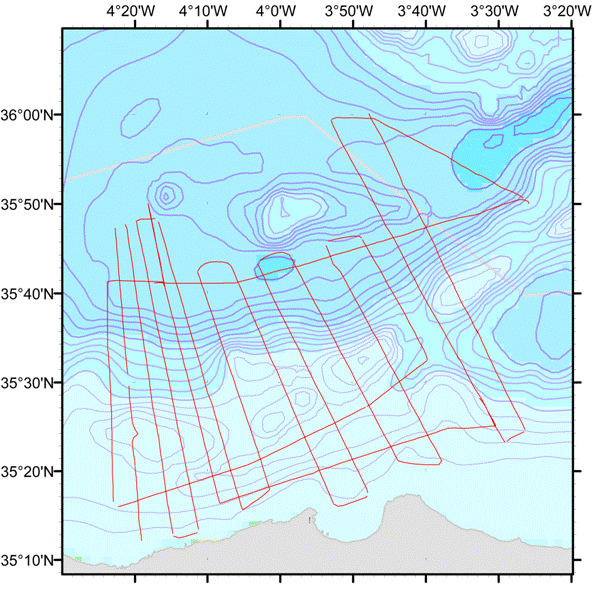Creation year
2011
203 record(s)
Type of resources
Categories
Topics
INSPIRE themes
Keywords
Contact for the resource
Provided by
Years
Formats
Status
-
The cruise is a component of RAPID-WATCH, whose objectives are: to deliver a decade-long time series of calibrated and quality-controlled measurements of the Atlantic MOC from the RAPID-WATCH array and; to exploit the data from the RAPID-WATCH array and elsewhere to determine and interpret recent changes in the Atlantic MOC, assess the risk of rapid climate change, and investigate the potential for predictions of the MOC and its impacts on climate. Objectives of this cruise: to recover, calibrate and redeploy moorings from the eastern boundary and mid-Atlantic ridge subarrays of the 26.5N line of RAPID moorings.
-
Charter cruise with the objective of validating the performance of SERCEL equipment, i.e. evaluation of different seismic devices and validating this equipment.
-

This cruise aims to investigate the seismic stratigraphy and palaeoceanographic evolution of the Le Danois contourite depositional system (Van Rooij et al., 2010), at several locations in the Le Danois "intraslope basin". Previous research (R/V Belgica in 2004, among others) has highlighted a significant correlation with the Cadiz CDS, suggesting a nearly simultaneous control by the Mediterranean Outflow Water since the Early Pliocene. As such, the Le Danois CDS is the only location in the Bay of Biscay where high-resolution climate change (e.g. bottom currents) may be recorded in a continuous way. It will assist in better constrain the role of the MOW in the thermohaline circulation system. Therefore, this large-scale sediment body is an ideal target for (a) investigating the MOW palaeoceanography within the NE Atlantic basin and (b) a palaeoclimatologic reconstruction of the Cantabrian margin. The main objective of this campaign is to acquire additional geophysical data which will give more insight in the construction and 3D evolution of this sedimentary deposit. This campaign will be executed in close cooperation with the Proyecto Coordinado CONTOURIBER (CTM 2008-06399-C04/MAR), with invited researchers from Spanish research institutes. More specifically, R/V Belgica ST1118a aims to perform: 1.High-resolution single channel sparker seismic profiling: investigation of the stratigraphic framework and the sedimentary environment in the western part of the intraslope basin between the Vizco High (west), the Lastras canyon system (east), Le Danois bank (north) and the Asturias slope (south). This will mainly focus on the lateral and temporal evolution of Le Danois drift and the Gijon drift and their interaction. The location of these profiles is determined based on industrial multichannel airgun profiles, in order to compare seismic methods with different penetration depths and seismic resolutions. We are very grateful to TGS-NOPEC for allowing us to use a large unpublished data set of seismic records from the Cantabrian Sea. 2.Hydrography: at specific sites in the intraslope basin, CTD casts will aim to better map the presence and behavior of the Mediterranean Outflow Water within the main elements of the Gijon and Le Danois drifts. The newly acquired Seapoint turbidity sensor will be able to indicate regions of active sediment transport within the Le Danois CDS. Multibeam bathymetry with the Belgica EM1002 will be only be used as a backup in case of spare time or failure of the other methods. The proponents are aware of the Marine Protected Area status of the Le Danois Bank, and will be vigilant to respect the guidelines of conducting scientific research. In order to ensure vigilance with respect to marine mammals, a team of whale watchers of MUMM, ULg (Belgium), CRMM (France) and OCEAMM (France) will be participating. This part of the campaign is a cooperation between the RCMG (UGent), the University of Vigo, the Geological Survey of Spain (IGME), the Spanish Oceanographic Institute (IEO), the Spanish Institute of Marine Sciences (CMIMA-CSIC) and the University of Cádiz.
-
The purpose of the cruise was the refurbishment of an array of moorings on the mid-Atlantic Ridge and off the Moroccan Coast at nominal latitude of 26.5°N. The moorings are part of an Atlantic-wide mooring array for monitoring the Atlantic Meridional Overturning Circulation and Heat Flux. The array is a joint UK/US programme and is known as the RAPID-WATCH/MOCHA array. The RAPID transatlantic array consists of 24 moorings of which 21 are maintained by the UK, and 20 bottom landers of which 16 are maintained by the UK. The moorings are primarily instrumented with self logging instruments measuring conductivity, temperature and pressure. Direct measurements of currents are made in the shallow and deep western boundary currents. The bottom landers are instrumented with bottom pressure recorders (also known as tide gauges), measuring the weight of water above the instrument. A sediment trap mooring NOGST was also recovered and redeployed for the Ocean Biogeochemistry and Ecosystems Group at the NOCS. CTD stations were conducted at convenient times throughout the cruise for purposes of providing pre and post deployment calibrations for mooring instrumentation and for testing mooring releases prior to deployment. Shipboard underway measurements were systematically logged, processed and calibrated, including: waves (spectra of energy and significant wave height), surface meteorology (air pressure, temperature, wind speed and direction and radiation (total incident and photosynthetically active), 6m depth sea temperatures and salinities, water depth, navigation (differential GPS measurements feeding two independent and different receivers, heading, pitch and roll from a four antenna Ashtec ADU5 receiver, gyro heading and ships speed relative to the water using an electromagnetic log). Water velocity profiles from 15m to approximately 500m depth were obtained using a ship mounted 75 kHz acoustic Doppler current profiler. Seawater samples from CTD stations and of the sea-surface were obtained for calibration and analysed on a salinometer referencing these samples against standard sea water. For velocity data (wind and currents) measured relative to the ship considerable effort was made to obtain the best possible earth-referenced velocities. Four APEX Argo floats supplied by the Met Office were deployed at pre-assigned locations, filling gaps in the network.
-
The objective of this project is the investigation of the structure and functioning of different CWC successional habitats (living, dead and buried corals), in order to understand the response of the CWC to a changing ocean. Therefore, we identified 4 specific objectives which will allow us to get insight in the distribution of these CWC habitats (objective 1), the responsible environmental drivers (objective 2), the associated (molecular and morphological) biodiversity (objective 3) and the connectivity between distinct CWC habitats at different spatial scales (objective 4). We will concentrate our study on the Bay of Biscay by providing multiple-scale analysis of habitat mapping, environmental characterisation, biodiversity patterns and processes of interconnectivity. However, comparisons will be made through European-US collaboration with other regions at both sides of the Atlantic in order to understand amphi- and trans-Atlantic distribution patterns and processes. This project is part of the 7th EC Framework Programme Hermione (Hotspot Ecosystem Research and Man's Impact On European Seas) (2011-2013).This monitoring project aims to execute a continuous research on the effects of the exploitation of non-living resources of the territorial sea and the continental shelf on the sedimentary movements and the marine environment (Law of 13 June 1969 on the exploration and exploitation of non-living resources of the territorial sea and the continental shelf). Belgian national research program.
-
The cruise D361 forms part of a study entitled 'Physical and chemical forcing of diazotrophy in the (sub)-tropical Atlantic Ocean'. The study is investigating the potential influence of iron and phosphorus availability on nitrogen fixation in regions of the tropical Atlantic Ocean. The cruise also undertakes deep trace metal clean CTD casts as part of the International GEOTRACES programme. The purpose of the cruise therefore is to undertake measurements of dissolved and particulate iron and phosporpus availability, their spatial and temporal variations, and their impact on diazotrophy in the surface ocean. Aim: To quantify the supply and determine the biogeochemical cycling of Fe and other nutrients, and relate this to N2 fixation, diazotroph species distribution and N* fields. 1. Quantify the distribution of nutrients and trace metals: Quantify surface water and water column distributions of dissolved inorganic/organic N, P, Fe, and DAl, DMn and particulate P, N, Fe, Al, Mn. 2. Quantify the rate of Fe, Al, Mn, P and N supply to surface waters: Assess the source fluxes of the key elements for diazotrophs and source tracers to the surface ocean from atmospheric deposition and internal transport via diapycnal mixing and lateral advection. 3. Identify the source of subsurface Fe enrichment: Identify whether Fe-rich subsurface waters of the tropical North Atlantic thermocline originate from the atmosphere or the shelf using Fe distributions and Al, Mn, and O2 source tracers. 4. Quantify the diazotrophic response to Fe, phosphate, DOP supply: Relate the spatial distributions of inorganic Fe and organically complexed Fe, and phosphate and DOP to diazotrophy. The specific uptake of Fe, phosphate and DOP by the whole microbial community and Trichodesmium will be assessed by shipboard incubations, radiotracer techniques and enzyme bioassays. In addition, we will identify the connection between N2 fixation rates and diazotroph community structure, by comparing size fractionated 15N2-derived rates of N2 fixation (Fig. 1) with abundance and diversity of diazotrophs using nifH phylogeny. Objective 5: Investigate how the large scale transport pathways of Fe and P influence the N* distribution: Use fine-scale isopycnic model to reveal the large-scale transport pathways of Fe and P in the (S)-T Atlantic, and their effect on the N* distribution.
-

Characterizing the variability of hydrological and current measurement features and particulate fluxes in two canyons of Le Planier (station PL1000) and Lacaze-Duthiers (station LD1000) located at the easternmost and westernmost tips of the Gulf of Lion. Since 2011, setting up a long-term frame of reference in the convection zone - PPS3 trap, buoy zone and LION line.
-
CTD stations on 20W line from 50N to 20N, following the old WOCE line A16N Physical measurements (CTDO and LADCP) and discrete samples for salt, oxygen, inorganic nutrients and alkalinity/inorganic carbon Underway ADCP, surface ocean measurements, surface meteorology measurements. Contribution to GO-SHIP sustained hydrography program. Partial repeat of a hydrographic line last occupied in 2003.
-

<p>The deep basin and continental shelf of the Gulf of Lion (North Western Mediterranean) are known for the formation of dense water in wintertime by the action of N-NW continental winds. This dense water is formed both offshore and at the coast. The area of Cap de Creus and its adjacent canyon is the main zone where dense coastal water is exported. Dense water dynamics on the continental shelf are also influenced by E-SE storms. Transfers of organic, inorganic, particulate and dissolved matter from the surface to the deep basin and from the shelf towards the slope by these physical processes can influence the redistribution of chemical elements in sediments, as well as the structure and functioning of benthic and pelagic ecosystems. The CASCADE cruise aimed to determine the characteristics of these two physical mechanisms and their numerous impacts, as well as monitoring changes in the hydrology, dynamics, sedimentology and biogeochemistry of water bodies. We propose a qualitative and quantitative estimate of particulate and dissolved, organic and inorganic matter fluxes exported towards the slope and the deep basin by these mechanisms.</p>
-

<p>The MARLBORO cruise project aimed to study Post-Messinian tectonic evolution in the South Alboran basin (Morocco). The presence of sediment formations, especially contourites (sediments deposited or reworked by marine bottom currents) and instabilities, deposited since the end of the Messinian (approx. 5.33 Ma), provide us with top rate sedimentary markers to recreate the tectonic evolution well. Moreover, the region is affected by strong quakes and by slope instabilities which cause concern. Although active accidents have been identified and recently mapped on the Andalusia margin, no such detailed studies have been conducted yet on the Moroccan margin. The Xauen/Tofino and Alboran ridges off Morocco, in the south of the Alboran Sea, were chosen for the study zone since they show both past and current signs of strong tectonic deformation, underwater landslides and activity of bottom currents whose contourite type deposits can provide an excellent stratigraphic marker. The cruise's objective was the imaging of post-Messinian structures using medium resolution reflection seismics. The cruise (7 days in the zone) made it possible to acquire about 1,100 km of reflection seismic surveys along the 15 profiles perpendicular to the ridges, and 3 profiles parallel to the ridges, in order to monitor the lateral and longitudinal evolution of contourites and of Mass Transport Deposits (MTDs), as well as the geometric relationships existing between these objects and active tectonic structures. The MARLBORO cruise is related to the French TerMex (Mediterranean margin) and Actions Marges (Améditer) programmes as well as to Spanish national Contouriber and SAGAS programmes and the international Topomed programme.</p>
 Catálogo de datos del IEO
Catálogo de datos del IEO